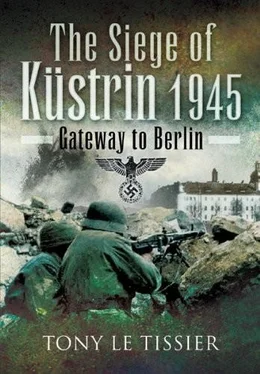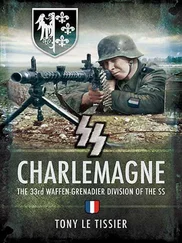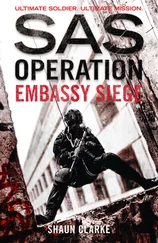I decided, after a difficult inner conflict, to give the order to attack Kuhbrücken-Vorstadt, a small part of which was still in our hands, with the aim of re-establishing the old front line. I waved aside the repeated appeals from my officers to break through to our own lines. Nevertheless, I had to consider that the troops upon the first successful advance with practically no ammunition would not be held back from breaking through any longer. I took this possibility into consideration.
This undertaking, in the assessment that an attack from the west appeared unlikely, had the moral advantage that the troops at least would die a decent soldiers’ death and be spared shame, and finally that the Russians would be prevented from acquiring over 1,000 labourers. Thus I was completely convinced I was dealing with the matter in the way the Führer would wish.
The attack, which then itself led to further breakthroughs, succeeded simply with ‘Hurrahs!’ without firing through the whole enemy lines. In so doing, two firing anti-tank guns and two heavy machine-gun crews were put out of action with rifle butts. Overall, how many of the remainder of the garrison got through, I have no overall view, but believe that it was a high percentage. Finally, I note that all the bridges, including the Vorflut railway bridge, were destroyed.
Annex C
Kreisleiter Körner’s Report
Potsdam, 5th April 1945
Reichsleiter Party Comrade Bormann
Wilhelmstrasse
Berlin
I have the following to report about the events of the last weeks in Küstrin Fortress. As all my notes, papers, etc. were destroyed without exception, I cannot give precise details and dates on individual events. I quote them only so far as my memory extends.
The Küstrin men and soldiers knew from the beginning of the battle that Küstrin had a great historical past and has a political and historical significance for the Greater German Reich. Their application to the fighting was thus particularly honourable. We were all imbued with the willpower to defend this old fortress town to the last round. This willpower alone, however, is only useful when the supply of manpower, weapons and ammunition is adequate. Unfortunately, during the ten weeks of siege we received no assistance from outside and no replacements for the tens of thousands of men either killed or wounded. To give a rough picture, I should mention that during the fighting the Wehrmacht was reduced from 11,000 to 1,200 men. The Volkssturm were reduced from 900 to about 118, the police from 65 to 14, the fire brigade from 80 to 20, and the Kreis administration from 30 to 12. Of these 12 only 4 Party members have reported surviving the breakout so far. These figures should bear witness to how heroically the battle was fought and with what meagre numbers a massively overwhelming enemy was held at bay for ten weeks. At a time when Küstrin was still relatively well equipped with heavy weapons, the artillery superiority of the Russians was calculated as 100:6, i.e. there were 100 Russian guns for every 6 German ones. During the last weeks, however, we had absolutely no heavy weapons any more. The enemy could do with us as he wanted. His aircraft romped around in the sky over the fortress unhampered by either German fighters or flak. In my opinion, Küstrin would only have fulfilled its role if it had had an establishment of about 60,000 men with the corresponding weapons. This strength was anticipated on paper, as far as I know. The most important aspects for Küstrin fortress were that the fortress outworks and the heights at Reitwein, etc., were occupied by our troops. In fact the Russians occupied those heights and thus had an advantageous view and excellent target in the fortress. Words do not suffice to begin to describe the courage and achievements. One must call to mind that the Küstrin garrison was completely cut off from the outside world for ten long weeks. Gas, electricity, sewage and water were lacking right from the beginning of the fighting. Thus there was no chance of listening to the radio, and no newspapers arrived. But there was strong artillery fire day and night. One alert followed another as the Russian attacks started. The air space over Küstrin was almost constantly overflown by Russian aircraft, dropping bombs and shooting up everything they could see on the streets. German flak and fighter protection were completely lacking. The men were under immense psychological pressure as they felt themselves completely abandoned and saw and noticed absolutely nothing of German military forces. The only fact on their minds was that they were fighting in a trap.
When the whole of Küstrin-Neustadt was lost in an afternoon in mid-March, the psychological pressure reached its climax. The Russians had taken the Neustadt from Alt Drewitz with tanks and infantry after several hours of artillery preparation. Allegedly it was not possible to receive warning of this danger in time. Elements of the fire brigade, police and other civil services, including the local Party leader, remained in the Neustadt. Apart from this, about 4,000 troops remained in the Stülpnagel Barracks and Engineer Barracks. But there were also other major installations of exceptional importance in the support of the fortress garrison. I mean the Army Supply Depot, the big Army Bakery, armoury and ammunition stores. For example, in the Norddeutschen Kartoffel-Mehlfabrik were stored foodstuffs to the value of 3.5 million Reichsmarks. The German soldiers in the Neustadt were commanded by Police Colonel Walther.
What became of those 4,000 troops nobody knows as yet. It was astonishing that the military authorities did nothing to rescue these soldiers or regain their fighting capability. No radio contact was made. At least one pitiful attempt was made to get radio sets across, but it failed. I have not heard of any repetition of this attempt. It should have been possible to arrange combat communications with these troops in advance.
The Wehrmacht had a dove unit in Küstrin, but the 270 letter-carrying doves had been taken away to Berlin several days previously. In any case I did not get the impression that everything was done to release the surrounded troops. I must also doubt that the commitment of the Luftwaffe in this urgent matter was asked for. One has an overall impression that the senior military authorities did not take the situation in Küstrin to be as serious as it really was.
If one had always reported the true situation clearly and unequivocally without embellishment, I cannot imagine that effective assistance would not have come from the outside. The bridges between the Altstadt and the Neustadt were blown at the correct moment. Individual soldiers and civilians swam across the Warthe and in this way were saved by the troops in the Altstadt. Even if a military operation had been impossible, one could at least have maintained contact with the German troops that had been cut off.
Following the fall of the Neustadt, in which, according to my reckoning, some 5–600 civilians still remained, the situation in the Altstadt was as follows. The Russian front in the north-east stood on the Warthe, in the south-east on the boundary of the Altstadt, in the south-west–except for a small bridgehead–on the Oder-Vorflut Canal. The fortress area was now reduced to only the Altstadt and was barely 2 kilometres long. The fortress was divided into two parts by the Oder. The Russians increased their rate of fire from all sides in the days that followed. The suburb of Kietz had already been razed to the ground by shelling and fires. All the buildings had been destroyed by the shelling and especially by fire. The defence possibilities were made even more difficult by the constrictions within the fortress. Heavy weapons had difficulty engaging any more. Many buildings had to be demolished in the Altstadt in order to provide fields of fire. The psychological pressure on the troops also increased under these circumstances. The Altstadt was known to be completely built up, the old buildings having been constructed with a lot of timber. Fire extinguishing equipment was largely lacking. Water could only be obtained from the fire-extinguishing wells, but extraction was limited. Everyone knew that should the Russians set fire to the Altstadt with their Stalin-Organs, nothing would be saved. Conditions in the cellars became increasingly unbearable. The Altstadt cellars at this time of year were always flooded from 10 to 20 centimetres. As the water continued to rise, so did the danger. Nevertheless, the troops beat back all the Russian attacks repeated daily.
Читать дальше












